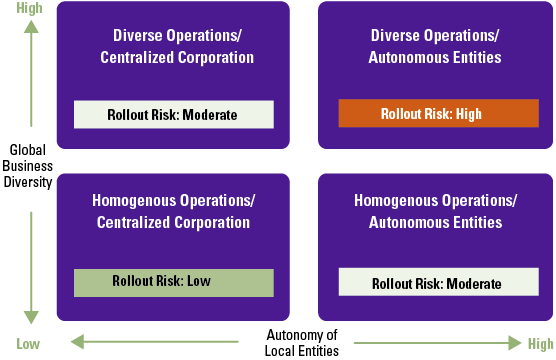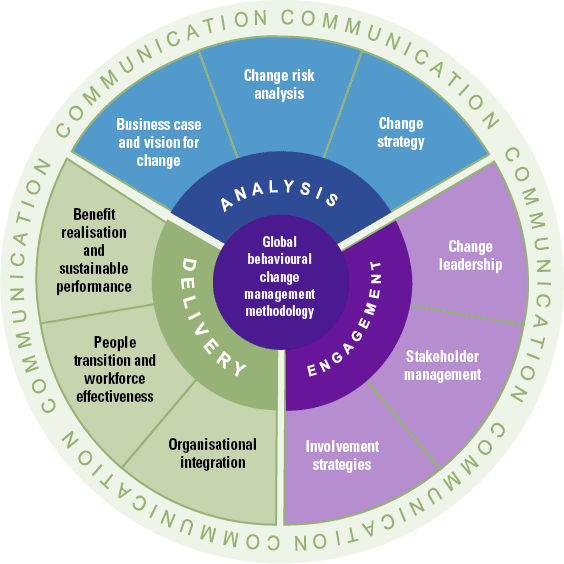While the implementation of a Global ERP solution is usually a long and costly undertaking, companies recognize the need to take this step towards achieving streamlined processes across local entities, often using a template approach. Based on the experience of several template rollouts at global companies, we offer some practical insights into the factors to take into consideration before and during the project for on-premise ERP systems as well as cloud solutions, some common risks as well as how these can be mitigated.
Introduction
Those organizations that have a global presence with local sites might experience that operations are run as individual subsidiary businesses where the general managers are responsible for their local profitability. This limits the level of central oversight and commonality across the business, therefore achieving fewer synergies in processes. These organizations usually seek a transition to achieve a global common platform where a single unfragmented ERP solution offers visibility of operations around the world. On the downside, going through such a global ERP transformation can be quite challenging and costly.
A template rollout approach offers a number of benefits which make it an attractive choice for global companies looking to make the most out of their ERP projects:
- process harmonization across business units;
- reduced implementation costs;
- reduced operational costs;
- easier enablement of corporate IT/governance.
To be sure of success, implementation parties need to overcome technical, organizational and cultural challenges. It is of the utmost importance that adequate effort is spent on building the template. In most cases a global template is built and then deployed in one country, to be then followed by several parallel deployments. This ensures that the template is of good quality and is usable in practice before the rollout on a large scale in multiple countries. This is because poor design decisions in defining the template and insufficient testing can result in a lot of additional effort and costs as the deployment takes place. Therefore, the technical solution requires a well thought-out target operating model, effective master data management across the organization and planning for the dependencies with regard to interfaces.
In terms of organizational change, strong governance, decision-making and change management activities make the difference between a successful ERP program and a failure. Commitment at all levels of the organization can ensure that the defined project milestones are met, and the much feared delays we are rather accustomed to hear about in most ERP implementation projects are avoided.
These factors are important in an on-premise ERP implementation as well as in a cloud implementation. In rolling out a cloud ERP solution however, there are some additional factors that should be given consideration. These factors that organizations should especially pay attention to include:
- avoiding requirements that are not standard features of the cloud solution when defining the template;
- incorporating the upgrade schedule of cloud solutions in the project plan;
- preparing the local sites for the outsourced IT model;
- developing a training approach on a rolling basis fit for the incremental releases of the ERP vendor.
Rollout strategies: predefined template versus flexible template approach
When it comes to global ERP deployment, organizations have a choice between two main approaches that differ with regard to the degree of flexibility offered, the associated risks and costs. The first approach, using a predefined template containing target operation (TOM) and application models as well as project management and change management toolkits, is a common practice as it is regarded that this reduces implementation costs and standardizes business processes across business units. The second approach offers more flexibility to account for diversified business processes across geographies and autonomous local entities, where rolling out a rigid template can be highly risky. In this case, companies might opt for more flexible template rollout approaches, in which the template can be adjusted based on the additional requirements. The two approaches are introduced below.
- Predefined template: at one end of the scale, organizations can opt to build a predefined template based on the Target Operating Model. In other words, the project team builds a so-called kernel, which consists of a set of deliverables including project management tools, technical and functional design documents and a change management kit to be used in the rollout to the local sites at the onset of the project. For local entities, rolling out a predefined target operating model might mean changing their way of working. However it is commonly preferred due to the fact that the overall implementation costs are low and operations are standardized globally across the local entities.
The features of a predefined template are:- the organization benefits from the common processes, data standards and system usage after the deployment and has more visibility of the global operations;
- processes are very difficult to change once they have been established;
- only legal requirements are modified in rolling out the kernel.
- Flexible template: at the other end of the scale, a more flexible approach can be chosen where the initial template is created based on the standard functionality of the ERP system or the best practices. This template is then adjusted based on the needs of local entities as it is rolled out.
The features of a flexible template are:- the template is used as a suggestion;
- many discussions with the local entities are necessary during the rollout;
- to avoid the redundancy of business requirements, the local entities are charged for the costs of extra functionality.
Besides the predefined and flexible template approach, organizations might choose to use a combination of these strategies to different degrees. For example, an approach where an initial template is developed at the onset of the project but evolved by minimal adjustments in the course of the project provides a trade-off between the two extremes. However, the predefined template approach still seems to be the most commonly used strategy since the organizations can benefit from low cost of implementation and visibility across the local entities after go-live.
While implementing a single-country ERP system is a complex undertaking in itself, in the case of a predefined template rollout there are additional risk factors that can influence implementation. The two risk factors Global Business Diversity and Autonomy of Local Entities are shown in Figure 1.

Figure 1. Risk of rolling out a predefined template.
Typically, the risk is lowest in the case of an already globally homogenous and centralized corporation. However, as either the autonomy level or the global business diversity increase, the risk level associated with the implementation will also increase. The more autonomy the local business units have, the more difficult it might be to bring them on board with the new implementation.
In some cases, organizations aim at achieving a transformation towards a harmonized set of processes by implementing an ERP system. However, an ERP implementation often has to go in parallel with a transformation of the organization. In this respect, a serious and committed approach to change management is essential.
Based on our experience, the scope and the industry are also important to take into consideration when choosing the right approach for implementation. One of our clients in the manufacturing industry had a quite diversified structure across local sites in terms of size and complexity of the product. Rolling out a global ERP solution, we have seen that a more flexible approach is required as the diversity implied tailored manufacturing and planning operations. On the other hand, for another client that only required an implementation with a finance scope we observed that the rigid predefined template rollout approach was relatively easier to apply. The risk in using the predefined template for this type of implementations was, however, that the finance related legal requirements were quite diversified across countries and the localizations needed to be incorporated in the solution.
Key factors for a successful template approach
As addressed above, the predefined template approach is commonly used due to the benefits of harmonized processes and reduced implementation costs. However, this approach can bring some organizational, technical and cultural risks with it. In order to mitigate these risks and to reap benefits from a template approach, we have identified the following factors that are crucial for a successful global ERP implementation based on our experience. Note that defining the below factors we assume that the predefined template model is used. The flexible template use might require different considerations.
Template readiness
One of the crucial elements that organizations need to take into consideration before initiating a global rollout is to define a global operating strategy and business operations that are aligned with it. Having a clear vision and strategy for the global rollout, an organization designs the to-be state of things and the steps to achieve it via the ERP implementation. In other words, the organization should define a Target Operating Model, which is used to create a common understanding globally across the local entities. The strategic and operational drivers of the project should be reflected in the Target Operating Model which is part of the global rollout template.
The Global rollout template needs to reflect a common understanding across the local entities and their buy-in into the project can be facilitated by an adequate degree of involvement in the template definition. In our experience, the involvement of local sites is important in defining the Target Operating Model especially when the local firms are enabled to make autonomous strategic decisions based on their local needs, market conditions and demands.
Strong governance
A clear vision and strong governance from the outset of the global program is necessary to ensure that all stakeholders know exactly what is expected of them and are committed to play their part. The leadership of the project as well as the organization itself also need to be aware that changes will need to be dealt with as they arise. Decisions need to be made at the right level and with the right stakeholder involvement, to make sure they are propagated through the organization.
Our observation is that companies where the local sites act as independent entities experience problems in governing the original template. In cases where the governance on controlling the need of change requests is weak, local member firms/business units might submit redundant amount of cases for change (demand), with central providing the role of a pure supplier. Typically a greater balance is expected with more central push of the Global Template as part of an agreed global business case.
To ensure strong governance, the global and local process owners should have clear roles and responsibilities to be able to leverage their decision making authority in order to influence, strengthen and align global, regional and local networks.
Proactive change management
ERP implementations, especially those on a global scale, bring about transformational changes affecting all aspects of an organization and its way of working. Therefore, change management cannot be left as an afterthought of the ERP implementation, but needs to work alongside project management in a leading role during the project. When doing a template rollout, the experiences gained and tools and materials developed in one rollout can be used and improved upon in the following ones. The KPMG Global Behavioural Change Management Methodology shown in Figure 2, provides a basis which can be expanded and customized to the needs of a specific client. The main aspects of change management are Analysis, Engagement and Delivery.

Figure 2. The KPMG Global Change Management Methodology.
In order to achieve the benefits of a Global ERP system, Sustainable Change Management needs to be set in motion during the preparation phase and be a driving force during the entire ERP programme. This is achieved in close collaboration between the organization and the (external) change management party, where each is responsible for specific aspects of the change management process. Throughout the ERP programme, change management needs to ensure that organizations, leadership and employees are:
- clear on what the change means for behaviors and ways of working;
- aware of the reasons for and benefits of the change;
- ready, willing and able to implement change.
A key element in the KPMG Global Behavioural change management framework is communication: at all levels of the organization and at all stages of the project. Transparent and structured communication lines need to be established within the regular and project organization. This is achieved by defining a communication plan to provide timely and consistent information to the right levels within the organization.
Employees will show a tendency to not commit if they do not feel at least adequately informed about the upcoming changes. It is natural that they do not feel confident about using new ERP software that brings major changes to their daily way of working. They may not understand the need to go through a transformational project if they are not made aware of the benefits it will bring to the organization as a whole and are not involved in the correct way. The change vision and case for change need to be communicated as a step towards creating ownership of the solution. The translation from vision to reality for the people in the organization needs to answer the question: ‘What does this mean for me?’ and prepare them via training for the new way of working. Adequate training will improve the way employees feel about the change and their acceptance of the new ERP system.
Skills, roles and responsibilities
Typically, complex global ERP projects last for long periods of time and in some cases the ERP solution is rolled out in parallel to multiple sites which are located in distant countries. Therefore it is natural to expect problems relating to culture, workload, communication, responsibilities and skills to arise. Another key factor in a successful implementation is to define an effective resource plan that can accommodate a global implementation with the right skills and roles. While it might be relatively easy to analyze what went wrong in retrospect, it is not very easy to predict the dynamics within a team and across teams in the program as a whole at the onset of a global implementation.
In order to tackle these types of problems, clear roles and responsibilities in the regular organization and program organization, both central and local, internal and external, need to be defined from the start as part of a shared effort from the implementation team and the management. When forming the project team common practices include a central implementation team with local project teams or deployment centers. When doing this, it is important to accommodate the people with the right skills, define a clear RASCI1 and to review and assess the existence of duplicative Global and Regional resources and look for ways to consolidate.
Quite often, offshore resources are employed as part of large implementation projects. In this case the cultural gap as well as the communication across different countries or even continents should not be underestimated. Making use of technology like video conferencing can nowadays be a good replacement to long, time-consuming and costly trips around the world.
Finally, within an ERP project, the business analysts constitute around 70% of the team, it is therefore important to choose a balanced team sufficiently flexible to adopt non-traditional roles. The definition of ‘good’ extends beyond technical skills and previous implementation experience. This becomes even more important in the case of a Global team, with a mix of cultural diversity and backgrounds.
Common master data definitions
Data plays a vital role in every organization. When deploying an ERP system, it is easy to fall into a ‘local thinking model’. The consequences of this type of thinking often only become visible much later on, as conflicts arise when more countries join the system. The actual effort to correct can vary broadly.
This can be prevented by having a clear vision and setting up the necessary Master Data Governance structure early on.
Managing dependencies with other integrated systems
ERP systems are often at the center of a complex system landscape. An ERP system usually sets out to replace a multitude of systems, and in addition it still needs to communicate with other interfacing legacy systems. In our experience, it is crucial to include management of the interfaces in the overall deployment plan and facilitate the communication between the responsible stakeholders for each system in advance. In rollouts where this is not paid enough attention, there is a significant risk of business disruption after the go-live period.
Additional considerations for cloud implementations
The above named factors are crucial for on-premise implementations as well as cloud ERP implementations. When it comes to cloud implementations however, there are other factors that require special consideration including the design of the target operating model, the deployment method and change management approach.
Pre-defined template approach is more fit for cloud ERP implementations
When we compare the ERP cloud solutions to traditional ERP systems, it is important to note that the share model of cloud systems provides an incentive to use standard cloud ERP functionality rather than customization. Hence it is easier for the implementation parties to present their own pre-configured templates to the clients in order to enable them to rapidly set-up a new TOM using modern industry standards, and translated into ERP Cloud functionality. This provides clients with the ability to speed up the validation and construction phases of the project and come to a configuration in a short timeframe.
The best practice suggested by ERP vendors of cloud solutions is to move away from the traditional methods such as ‘Solution Design’, ‘Requirement Gathering’ , ‘Fit/Gap Analysis’ to use the packaged solutions as offered by the vendors. Instead the suggestion is to make use of questionnaires in order to understand business processes and configuration requirements for the cloud solution. It is also important to emphasize to the client from the presales stage that the ideal implementation that the organizations can make the most benefit from is solution driven and not requirement driven. In this sense, we believe that the pre-defined template approach is more suitable for cloud ERP implementations.
Consider the cloud upgrades and integration with on-premise systems in your deployment plan
The nature of cloud implementations requires a fine-tuned approach in terms of program management of the rollout. To be more specific, cloud technologies are relatively new and typically, the ERP vendors adopt an approach to release new features incrementally over time instead of a big-bang development approach. This will have consequences for any cloud implementation project, meaning that the project plan should incorporate the periodical upgrades of the cloud system. Ideally, organizations will want to avoid a go-live during the upgrade for a stable environment. The suggestion by the ERP vendors for the initial implementation is to typically plan a go-live date after a few weeks of a periodical upgrade so that latest fixes and new features have been applied to the updated release.
In addition, as in any cloud implementation, the integration with the on-premise systems should be planned in advance. This is especially important in a global rollout where different local sites might have a variety of local systems interfacing to the global ERP cloud system. The global system architecture should also account for these complexities, and possible rollback strategies should be included in the project plan.
A switch from the local to an outsourced IT model requires proactive change management
Medium to large size corporations have usually settled IT organizations where they manage their own network, data-center, development of customizations to serve the local business requirements and maintenance activities. Switching to ERP cloud systems means bringing the costs of operations down but this at the expense of independent infrastructure management, non-standard ERP functionalities and onsite maintenance. This change in the IT organization is likely to create disruption and thus resistance within the IT organization as well as among the users.
This requires a proactive change management approach, meaning the local entities should be informed from the onset of the project addressing the global and local benefits of moving to the cloud. The communication should also inform the local organization how the governance structure within the global organization will look like including the outsourcing model of maintaining the application and the infrastructure.
Training approach should be suitable for incremental changes
As discussed above, the training strategy has an important role in preparing the users for the implementation based on the role-based needs. As well as traditional ERP implementations, this is also a crucial aspect of the change management. What differentiates cloud ERP implementations from the on-premise implementations, however, is the concurrent upgrade nature of the cloud implementation. In other words, cloud vendors often follow an agile approach releasing the new features, meaning there will be incremental improvements over time. This also requires special attention and effort, not only during the go-live but also in the post implementation period. The ideal training approach in this case is to train the users on a rolling basis as the new features are released instead of training every new functionality at once. This will also make the change and user adoption process smoother.
Conclusion
A global rollout of an ERP system is a common practice for the organizations that aim to benefit from harmonized business processes and visibility of operations across the local entities. However, it brings a lot of complications as the local entities’ business processes might be divergent and they might have non-autonomous management policies. Depending on these factors, the organizations can choose different rollout strategies. They might opt for defining a global template at the onset of the project and strictly rolling it out to the local entities. As another option, they might allow for some flexibility and define the template along the project implementation based on the local business needs. In practice, most companies choose for the first option as it implies lower costs, however to ensure the success of a global ERP template the following considerations must be taken into account:
- template readiness;
- strong governance;
- proactive change management;
- skills roles and responsibilities;
- user training;
- common master data definitions;
- managing dependencies with other integrated systems.
Even though rollouts of cloud ERP solutions have similar success criteria, there are a few additional factors that impact the implementation and make the companies benefit from the advantages of cloud:
- Pre-configured template used is suitable for cloud solutions instead of designing new solutions based on requirements.
- Deployment Strategy should be in line with the schedule of upgrades and releases for fixes.
- Change Management should address the benefits of moving to cloud in the outsourced IT model.
- User training approach should be suitable for incremental feature releases.
Notes
- A responsibility assignment matrix (RASCI) describes the participation by various roles in completing tasks or deliverables for a project where RASCI stands for R = Responsible, A = Accountable, S = Support, C = Consult, I = Inform.




